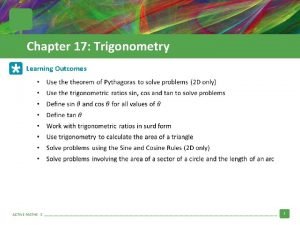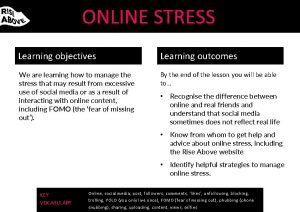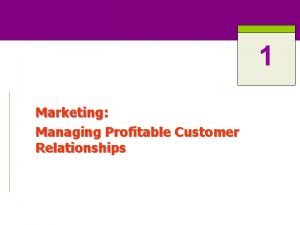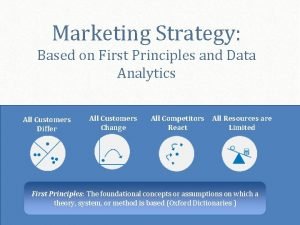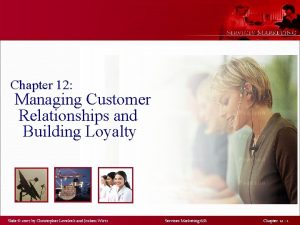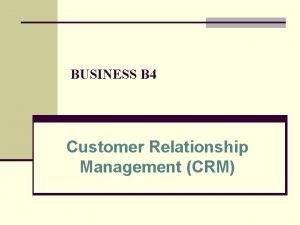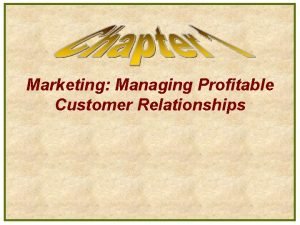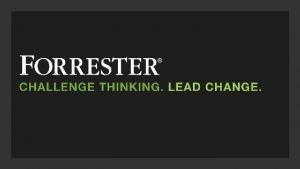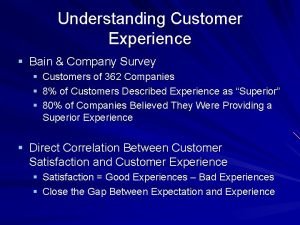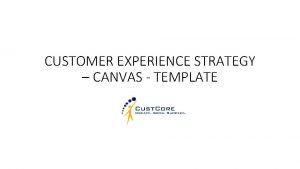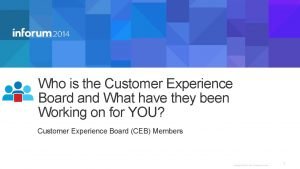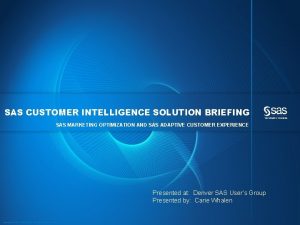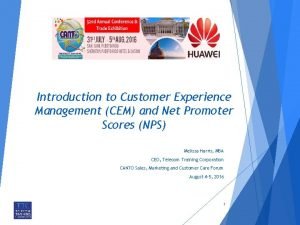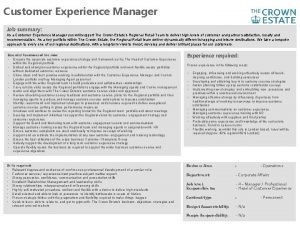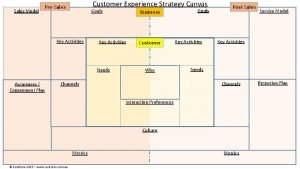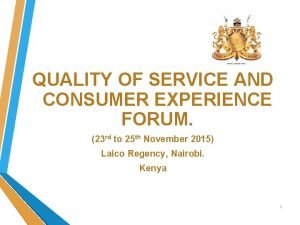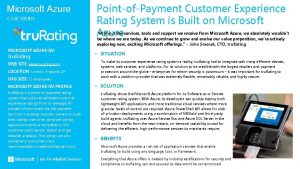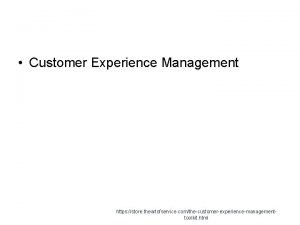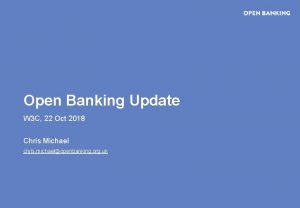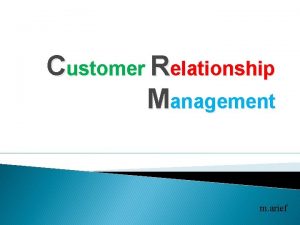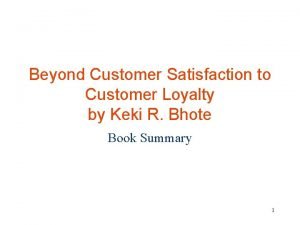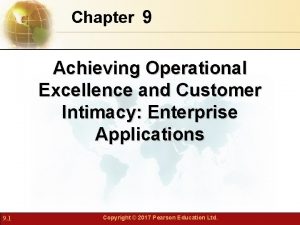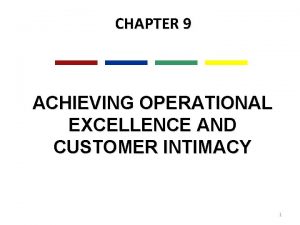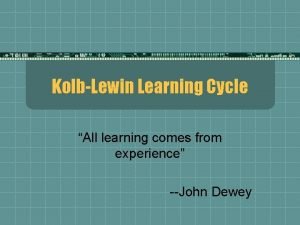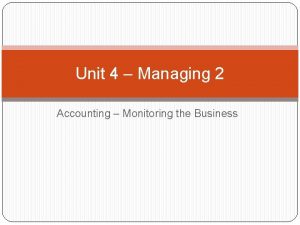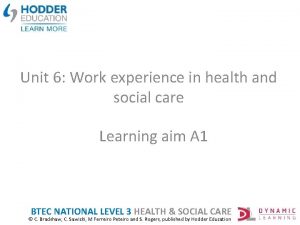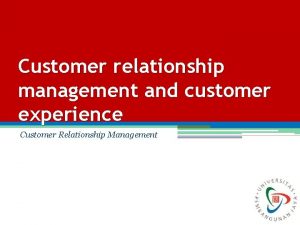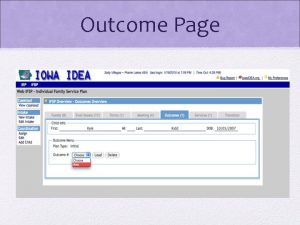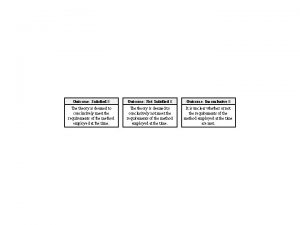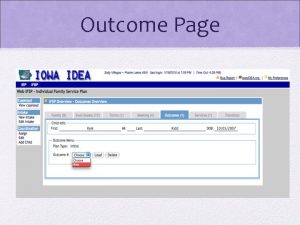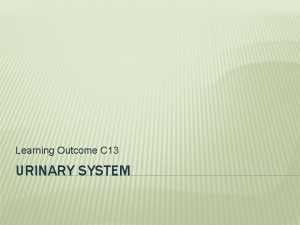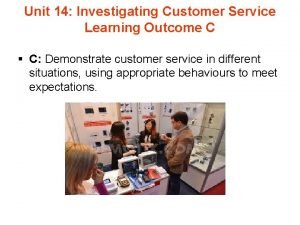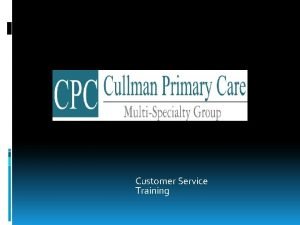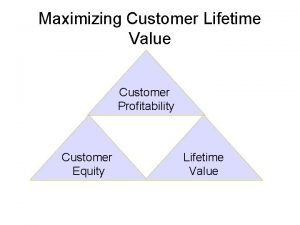UNIT 2 MANAGING THE CUSTOMER EXPERIENCE LEARNING OUTCOME




















































![BIBLIOGRAPHY References Bauer, E. (2017). An Introduction to Different Types of CRM Systems. [Blog] BIBLIOGRAPHY References Bauer, E. (2017). An Introduction to Different Types of CRM Systems. [Blog]](https://slidetodoc.com/presentation_image_h2/fe89d553823a08a88d327a889c0256c3/image-53.jpg)
![BIBLIOGRAPHY Salesforce. (2017). What is CRM? . [online] Available at: https: //www. salesforce. com/eu/learning-centre/crm/whatis-crm/ BIBLIOGRAPHY Salesforce. (2017). What is CRM? . [online] Available at: https: //www. salesforce. com/eu/learning-centre/crm/whatis-crm/](https://slidetodoc.com/presentation_image_h2/fe89d553823a08a88d327a889c0256c3/image-54.jpg)
- Slides: 54

UNIT 2 MANAGING THE CUSTOMER EXPERIENCE

LEARNING OUTCOME 3 INVESTIGATE THE IMPACTS OF DIGITAL TECHNOLOGY IN CUSTOMER RELATIONSHIP MANAGEMENT

P 5: EXAMINE HOW DIGITAL TECHNOLOGY IS EMPLOYED IN MANAGING THE CUSTOMER EXPERIENCE WITHIN THE SERVICE SECTOR, PROVIDING SPECIFIC EXAMPLES OF CUSTOMER RELATIONSHIP MANAGEMENT (CRM) SYSTEMS

CUSTOMER RELATIONSHIP MANAGEMENT; WHAT IS Salesforce (2017) defined Customer relationship management (CRM) as a strategy widely used by companies and organizations (including related integrated information systems and technology, often in the form of software) to record and manage their overall data and interactions with current, past and potential customers. CRM works to ensure that all customer-interfacing organizational functions (i. e. , sales, marketing, technical support) are efficient and synchronized, ensuring that former and potential customers are adequately and appropriately served.

CUSTOMER RELATIONSHIP MANAGEMENT; WHAT IS The most critical purpose of CRM is to manage each instance of the company’s customer interaction. CRM manages, stores and disseminates customer information with many built-in tools that can be applied to raw data pertaining to a customer or any given category of customer. For example, data may be analyzed to segregate customers according to demographic, occupation and age, etc (Lahiri, 2015). CRM plays a vital role in an organization’s marketing and research departments. For example, if data indicates that a majority of customers are from Texas, a sales and marketing department can customize strategies for that state. These and other datamining efforts may show trends to help businesses make better strategic decisions, utilizing technology wisely to serve the needs and wants of customers (Techopedia, n. d. ).

CUSTOMER RELATIONSHIP MANAGEMENT AS A BUSINESS STRATEGY Kulpa (2017) analyses the elements of Customer Relationship Management (CRM) as all about the finding, acquiring, and retaining the best, most profitable customers. CRM systems offer an easy to use and automated means of managing the loads of valuable information about your company accounts and the various dealings with the people. With successful CRM in good working order you can use this knowledge database to make faster, smarter decisions. You can work more productively by focusing on the best customers and new prospects, making sure you are top of mind when your company's offering is needed.

CUSTOMER RELATIONSHIP MANAGEMENT AS A BUSINESS STRATEGY CRM as a strategy places the customer at the center of a business. When properly implemented, the goal is to give progressively deeper information about customers - information that supports the business areas of marketing, product planning, sales, service and support. The goal of this customer-centricity is to promote customer loyalty, increasing the lifetime value of each relationship. As the value of customer relationships increase so will the value of the business. CRM in place is an asset that appreciates the value of your business (Wooden, 2018).


CUSTOMER RELATIONSHIP MANAGEMENT AS A BUSINESS STRATEGY Wooden (2018) goes on to highlighting that CRM is a business strategy focused on maximizing value of your business through winning, growing, servicing and keeping the right customers. It centers business operations around the customer and better ways to serve them. As a business strategy, CRM helps a company stay focused on delivering the best services and products to the appropriate target customer. It enables any representative of the company, whether sales representative or service person, to remember who they are talking to, no matter what the transaction might be.

CUSTOMER RELATIONSHIP MANAGEMENT AS A BUSINESS STRATEGY CRM affects all aspects of the customer interaction, whether marketing, sales, or services related. At every step of your business process, from initial prospect contact, to follow up communications, to placing an order, to service delivery, and managing ongoing relationships. These are opportunities to build upon and manage the customer relationship more effectively.

CUSTOMER RELATIONSHIP MANAGEMENT AS A BUSINESS STRATEGY CRM encompasses the "customer facing" functions of sales, marketing and customer service as well as back-office operations and new product development. A fully developed CRM system will embrace tying in information from the related systems as needed. Although initial implementation goals might focus on the front office, ongoing planning should address how these other areas will cooperate with your CRM initiative (Lamont, 2001). For a small business is may involve integration with Quick Books, Peachtree or Sage 100/200 (MAS 90). For larger business such as manufacturing it may involve Sage X 3 ERP and more sophisticated CPQ - configure, price and quote systems.


CUSTOMER RELATIONSHIP MANAGEMENT AS A BUSINESS STRATEGY Customer-centricity, or organizing the entire small business or enterprise around putting the customer first will drive redesign of company processes and workflow. This is enabled through the use of the appropriate CRM technology solution to meet the new objectives of the organization.

CUSTOMER RELATIONSHIP MANAGEMENT AS A BUSINESS STRATEGY Kolowich (2019) identified several key factors: • Enabling the identification and targeting of the company's most profitable customers, supporting the management of marketing campaigns with clear goals and objectives, and the generation of quality leads for the sales team. • Improving the lead qualification, account, call-center and sales management by optimizing information shared by multiple employees. Additionally streamlining existing processes such as workflow of prospect calls, alerting of new leads, automatically follow up activity generation.

CUSTOMER RELATIONSHIP MANAGEMENT AS A BUSINESS STRATEGY • Personalizing relationships with customers with the aim of improving customer satisfaction, the all-important "customer experience" and maximizing profits. CRM creates a two-way dialog between you and each individual customer. • Providing employees with the information and processes necessary to know their customer more deeply, understand their needs, and effectively build relationships between the company, its customer base, and distribution partners. Business process management and workflow solutions are now more effective and valuable, such as Task Centre. • Summarizing trends so they appear more quickly so the business is less reactive and more proactive in meeting the customer requirements. Today this is found in various business analytics and executive management dashboards.

BENEFITS OF CUSTOMER RELATIONSHIP MANAGEMENT

CUSTOMER RELATIONSHIP MANAGEMENT; TYPES • Operational • Analytical • Collaborative (Bauer, 2017; JOHNSON, 2018)

OPERATIONAL As the name suggests, an operational CRM assists businesses in managing their day-to-day marketing, sales, and customer service operations. These platforms are the most common type of CRM and are popular among businesses in a wide range of industries. Operational CRMs are best suited for customer service, sales, and marketing operations. These CRMs are great at handling any customer-facing function (Johnson, 2018).

OPERATIONAL; COMPONENTS 1. Market Automation- these tools allow you to automate aspects of your marketing, so you can more effectively target customers at various stages of the sales funnel. Identify and target potential customers with through marketing automation. How? Well, you already have a database full of customer information. Why not use that information to identify the best possible prospects and focus your marketing efforts there?

EXAMPLE An operational CRM takes care of predictable tasks like initiating an email campaign whenever a new prospect enters the system.

OPERATIONAL; COMPONENTS 2. Service Automation- is designed to provide a higher level of customer service. This is all about customer service – Talking with and interacting with your customer. Operational CRMs take your customers’ emails, phone calls, webforms, and orders and tie them up in a nice package. This package follows your customer through their life with your company. Customer reaches out to your call center? No problem – The CRM provides your call center rep with a complete picture of the customers previous calls, their orders, and even their complaints. Customer calls to check on an order? Piece of cake – The CRM helps your team track the order from time of purchase through delivery. Customer emails to check on a previous complaint? Don’t fret – The CRM has the complaint logged along with the action your team has take to fix the issue (Bauer, 2017; Johnson, 2018).


OPERATIONAL; COMPONENTS 3. Sales Automation- is a major component of many CRM systems. This feature can help you manage your pipelines, nurture leads, acquire new customers, and onboard new clients with ease. This might involve automatically tracking a contact and updating their status from prospect to qualified lead once they’ve completed certain actions or met specific criteria (Bauer, 2017). Taking care of existing customers is important. But getting new customers is important, too. The service automation of a CRM ties in directly with the sales automation.

EXAMPLE Propeller’s CRM allows you to automate multi-step email campaigns designed to turn contacts into paying customers. You simply decide which activities or interactions trigger the campaign and the CRM takes care of the rest automatically.

OPERATIONAL; COMPONENTS Here’s how it usually works: prospect→ sale→ customer→ repeat customer. This lifecycle – all of it – from prospect to repeat customer, is housed in your CRM. How does this help your sales team? • Scheduled Follow-up- If someone says no to your sales pitch you probably don’t want to call them again the very next day. But you might try them again in six weeks or six months. Keeping track of your follow-ups, knowing who to contact and when, is imperative to any sales force (Bauer, 2017).

OPERATIONAL; COMPONENTS Missed follow-ups are missed sales. A CRM manages all this, and more. Many systems automate follow-up contact with customers, taking the responsibility out of the hands of your sales team. What if there’s a prospect who is combative and completely unwilling to listen to your pitch? No problem – Your CRM can flag this prospect’s record so you (or your colleagues) don’t contact him again.


OPERATIONAL; COMPONENTS • Manage your sales team- From a management perspective, it’s often hard to know who is doing what on your sales team. Depending on your business, it might even be hard to figure out who is making sales and who isn’t. Enter, the operational CRM system. Your CRM doesn’t just keep track of prospects and customers, it also keeps track of your team’s interaction with those prospects and customers. You can track, view, and report on your team’s performance and make strategic adjustments as needed.

ANALYTICAL An analytical CRM is all about data. This type of CRM gathers, stores, and analyzes information about your customers. This usually includes customer data, marketing data, sales data, and service data. Analytical CRMs make it easier to manage the processes of customer acquisition and retention, as well as keep track of customer details. This is an ideal solution for companies that want to collect and analyze a large amount of data (Johnson, 2018).

ANALYTICAL Bauer (2017) identified three (3) main functions: • Customer Acquisition: Turning prospects into customers and upselling where possible. • Customer Retention: Keeping current customers happy and coming back for more. • Managing Data: Tracking customer interactions and other information that can improve your bottom line.


ANALYTICAL • Customer Data- Get a cradle to grave picture of your customer. Location – Age – Gender – Marital status – Income bracket – these are all details your analytical CRM might capture. And there are many, many more data points the CRM can manage. Each piece of information you gather and analyze gives you a clearer picture of your customer. What are their buying habits? Their needs and wants? Use your CRM to report on customers and fine tune your marketing and sales efforts.

ANALYTICAL • Marketing data Now that you know how to dial in your marketing efforts, use your CRM to measure how it’s actually working. Plan your marketing campaigns based on your customer data reports. Once launched, measure the success of your campaign. Analytical CRM systems typically provide a wide range of reports to help you learn which customers convert the best, which campaigns are most successful, and which campaigns are making or losing money.

ANALYTICAL • Sales data How many sales did your company make on Black Friday? What about during your Memorial Day sale? Do your high-ticket items sell better in the winter or in the summer? Answer these questions and many others by running a detailed sales report from your CRM system. Not only does this data help you identify sales trends in a particular time frame, it can show you which geographic areas outperformed others and which products outsold others. Sales reports, coupled with your customer and marketing data, can help you plan ahead and retarget your efforts to draw new customers.

ANALYTICAL • Service data Analyzing your service data is a big deal. It can give you major insight into three key areas: customer satisfaction, sales opportunities, and employee performance. q Customer satisfaction Imagine all your customers were complaining about the same thing, but you didn’t realize it. What should’ve been a simple fix to increase your overall customer satisfaction could now snowball into a huge issue. A CRM system can allow you catch and address service and satisfaction issues early on.

ANALYTICAL Your CRM can help you identify and track these important aspects of customer complaints: v Type of complaint v Cause of the complaint v How the complaint was handled With this data on hand, you can quickly address the root cause of the complaint and fix it. From a customer service standpoint, you can develop the best way to deal with the complaints until they’re all resolved. Customers usually understand things can go wrong, but they have little patience for problems that don’t get resolved. Use your service data reports to attack service issues head on.


ANALYTICAL q Sales opportunities Your CRM system gives your staff insight into your customers’ biographical data, past purchases, and buying habits. This is a perfect set up for cross-sell and up-sell opportunities. You can train your staff to identify these prospects and use the CRM's data to maximize the sales opportunity.

ANALYTICAL q Employee performance We talked about tracking customer complaints. But your CRM can also help track how your employees are handling complaints and other interactions with your customers. Keep an eye on employee productivity, service levels, and identify areas for improvement with reports generated right from your CRM.

COLLABORATIVE This third type of CRM system is designed to improve the customer experience. Collaborative CRM features streamline communication for all parties - both between the customer and your company and between various departments and stakeholders. These CRMs enable companies to track and share customer data with everyone from vendors and suppliers to tech support and marketing managers (Bauer, 2017). Making this information available internally not only strengthens the relationships that hold your business together, but also keeps customers happy. It allows you to provide a seamless multi-channel customer experience across all points of contact.

COLLABORATIVE The collaborative system facilitates sharing information across your company. This could include sales and purchase history, customer service contact, marketing interaction, and technical support interaction. When customer information is collected, organized, and shared across your organization it gives your entire team unique insight into the customer’s needs. This collaboration happens in two parts – interaction management and channel management.

COLLABORATIVE ü Interaction management Knowing your customer is the first step in meeting their needs. Using a CRM system can make this a lot easier. Logging and analyzing every interaction a customer has with your company helps you identify issues with an individual customer as well as overall problems your customer base may be having.

COLLABORATIVE Imagine your customer calls up the tech support team for help with their new purchase. After some troubleshooting, their problem is resolved and they’re happy. In a few months, your customer reaches out to the sales team about another possible purchase. The customer expresses some concern about their earlier technical problems. The sales team doesn’t have access to a good CRM system, so they have no record of the customer’s past issues. Not a great place to start if you’re trying to close a sale.

COLLABORATIVE Now consider a sales team with access to a collaborative CRM. The sales rep can see a detailed account of the customer’s previous issue. He can address the concern before the customer even has a chance to mention it. The customer feels good. They feel like your company cared enough about their earlier problems to make a note of it. Now they’re likely to purchase from you again. We’ve all been there – You call a company with a problem. You explain the issue. Then you’re transferred to someone else. And you have to explain the issue again. You might’ve even been transferred again and had to explain it a third time. This is terrible customer service (Johnson, 2018).

COLLABORATIVE ü Channel management Learning and recording your customers’ contact preferences is just as important as knowing their history. Some people prefer text messages. Others prefer phone calls. A few might still prefer snail mail. Either way, you have to communicate with your customers the way they want. A collaborative CRM can record the preferred method of communication for each of your customers and then employ that channel with each contact.

COLLABORATIVE Effective communication with your customers can truly make – or break – your business. Here is an example:

EXAMPLE You’ve targeted current customers, women ages 25 -45 for your latest product launch. Your CRM database shows these customers prefer an even mix of email and postal mail communication. You decide to send all the customers in your buyer segment a postal mailing because it’s more cost effective.

EXAMPLE You’ve almost closed a deal with a huge client. You sent over your final presentation and wait to hear back. You follow-up a few days later, leaving a quick voicemail. You’re still waiting to hear back. You follow-up again in a week with another voicemail. Still nothing. Then you check the client’s record in your CRM. You find he prefers email communication. There’s even a note that he rarely checks his voicemail. You send an email and get a positive response in less than an hour.


TRAVEL AND TOURISM MARKETING 1. What is the purpose of a Customer Service Management Software? 2. What does ‘winning’ a new customer mean? 3. What is customer satisfaction? 4. What is customer Value? 5. Give an example of CRM

TRAVEL AND TOURISM MARKETING Social media has fundamentally changed the way that many companies communicate with and market to their target demographics. For the travel and hospitality sector, in particular, the rise of the Internet and the increased popularity of social channels has altered travel marketing. From the way that travelers research potential destinations to the activities that they participate in once they arrive, the new ways that consumers use social media to make purchasing decisions has influenced tourism marketing from start to finish.

TRAVEL AND TOURISM MARKETING Here are five ways tourism has been impacted: 1. Travel research transformed 2. Rise in social sharing 3. Enhanced customer service 4. Reshaping travel agencies 5. Changing loyalty programs
![BIBLIOGRAPHY References Bauer E 2017 An Introduction to Different Types of CRM Systems Blog BIBLIOGRAPHY References Bauer, E. (2017). An Introduction to Different Types of CRM Systems. [Blog]](https://slidetodoc.com/presentation_image_h2/fe89d553823a08a88d327a889c0256c3/image-53.jpg)
BIBLIOGRAPHY References Bauer, E. (2017). An Introduction to Different Types of CRM Systems. [Blog] Propeller. Available at: https: //www. propellercrm. com/blog/types-of-crm-systems [Accessed 8 Mar. 2019]. Carnoy, J. (2017). 5 Ways Social Media Has Transformed Tourism Marketing. [online] Entrepreneur. Available at: https: //www. entrepreneur. com/article/286408 [Accessed 8 Mar. 2019]. JOHNSON, C. (2018). In-Depth Comparison of the 3 Types of CRM. [Blog] Nextiva. Available at: https: //www. nextiva. com/blog/types-ofcrm. html [Accessed 8 Mar. 2019]. Kolowich, L. (2019). Lead Generation: A Beginner's Guide to Generating Business Leads the Inbound Way. [online] Blog. hubspot. com. Available at: https: //blog. hubspot. com/marketing/beginner-inbound-lead-generation-guide-ht [Accessed 8 Mar. 2019]. Kulpa, J. (2017). Council Post: Why Is Customer Relationship Management So Important? . [online] Forbes. com. Available at: https: //www. forbes. com/sites/forbesagencycouncil/2017/10/24/why-is-customer-relationship-management-so-important/#5 fab 56657 dac [Accessed 9 Mar. 2019]. Lahiri, P. (2015). Role of CRM (Customer Relationship Management/ Marketing) in business development. [Blog] Concept Research Foundation. Available at: https: //conceptresearchfoundation. com/2015/06/02/role-of-crm-customer-relationship-management-marketingin-business-development/ [Accessed 10 Mar. 2019]. Lamont, J. (2001). Analytical CRM: capturing data to cater to customers. KM World, [online] (2). Available at: http: //www. kmworld. com/Articles/Editorial/Features/Analytical-CRM-capturing-data-to-cater-to-customers-9217. aspx [Accessed 8 Mar. 2019].
![BIBLIOGRAPHY Salesforce 2017 What is CRM online Available at https www salesforce comeulearningcentrecrmwhatiscrm BIBLIOGRAPHY Salesforce. (2017). What is CRM? . [online] Available at: https: //www. salesforce. com/eu/learning-centre/crm/whatis-crm/](https://slidetodoc.com/presentation_image_h2/fe89d553823a08a88d327a889c0256c3/image-54.jpg)
BIBLIOGRAPHY Salesforce. (2017). What is CRM? . [online] Available at: https: //www. salesforce. com/eu/learning-centre/crm/whatis-crm/ [Accessed 8 Mar. 2019]. Techopedia. (n. d. ). What is Customer Relationship Management (CRM)? - Definition from Techopedia. [online] Available at: https: //www. techopedia. com/definition/1459/customer-relationship-management-crm [Accessed 8 Mar. 2019]. V-Align Technologies (2016). Benefits of customer relationship management. [video] Available at: https: //www. youtube. com/watch? v=kwf-TSp. Doy. A&t=155 s [Accessed 8 Mar. 2019]. Wooden, D. (2018). CRM Basics: CRM is a Business Strategy Centered Around the Customer and Why. [Blog] Success With CRM Consulting. Available at: https: //www. successwithcrm. com/blog/crm-strategy-centeredaround-the-customer [Accessed 8 Mar. 2019]. Wooden, D. (2018). CRM is Comprehensive. [image] Available at: https: //www. successwithcrm. com/blog/crmstrategy-centered-around-the-customer [Accessed 8 Mar. 2019]. Wooden, D. (2018). 3 Pillars of Business success with CRM. [image] Available at: https: //www. successwithcrm. com/blog/crm-strategy-centered-around-the-customer [Accessed 8 Mar. 2019].
 Marketing information and customer insights are
Marketing information and customer insights are Imprint definition psychology
Imprint definition psychology Early experience vs later experience
Early experience vs later experience Direct experience and indirect experience
Direct experience and indirect experience A machine that converts mechanical energy into electricity
A machine that converts mechanical energy into electricity Learning outcome of poem
Learning outcome of poem Veyldf learning and development outcome descriptors
Veyldf learning and development outcome descriptors Learning outcomes prescribes
Learning outcomes prescribes Learning outcomes of trigonometry
Learning outcomes of trigonometry Examples of learning outcomes
Examples of learning outcomes Learning objectives examples
Learning objectives examples Marketing is managing profitable customer relationships.
Marketing is managing profitable customer relationships. All customers differ
All customers differ Managing customer relationships and building loyalty
Managing customer relationships and building loyalty Involves managing all aspects of a customer relationship
Involves managing all aspects of a customer relationship Customer relationship matrix
Customer relationship matrix How to measure digital customer experience
How to measure digital customer experience Customer experience bain
Customer experience bain Radical customer experience
Radical customer experience Customer experience strategy template
Customer experience strategy template Maturity model template
Maturity model template Customer experience management conference 2011
Customer experience management conference 2011 Customer experience board
Customer experience board Sas adaptive customer experience
Sas adaptive customer experience Introduction to customer experience management
Introduction to customer experience management Introduction to customer experience management
Introduction to customer experience management Customer experience manager job description
Customer experience manager job description Sales model canvas
Sales model canvas Quality & customer experience forum
Quality & customer experience forum Azure customer experience
Azure customer experience Bernd schmitt customer experience management
Bernd schmitt customer experience management Open banking customer experience guidelines
Open banking customer experience guidelines Customer experience solutions llc
Customer experience solutions llc Cuadro comparativo e-learning y b-learning
Cuadro comparativo e-learning y b-learning Customer relationship management and customer intimacy
Customer relationship management and customer intimacy Perbedaan customer relation dan customer service
Perbedaan customer relation dan customer service Beyond customer satisfaction
Beyond customer satisfaction Customer relationship management and customer intimacy
Customer relationship management and customer intimacy Intimacy
Intimacy Unit 10, unit 10 review tests, unit 10 general test
Unit 10, unit 10 review tests, unit 10 general test Accessible learning experience design and implementation
Accessible learning experience design and implementation Integrative learning experience
Integrative learning experience Contrived experience
Contrived experience Language experience approach
Language experience approach Learning comes from experience
Learning comes from experience Unit 6 managing a successful business project
Unit 6 managing a successful business project Managing a successful business project
Managing a successful business project Unit 6 managing a successful business project
Unit 6 managing a successful business project Unit 5 managing networks
Unit 5 managing networks Unit 10 managing people
Unit 10 managing people Managing credit unit test answers
Managing credit unit test answers Unit 6 managing a successful business project
Unit 6 managing a successful business project Unit 4 managing an event
Unit 4 managing an event Unit 6 work experience in health and social care level 3
Unit 6 work experience in health and social care level 3 Hình ảnh bộ gõ cơ thể búng tay
Hình ảnh bộ gõ cơ thể búng tay








